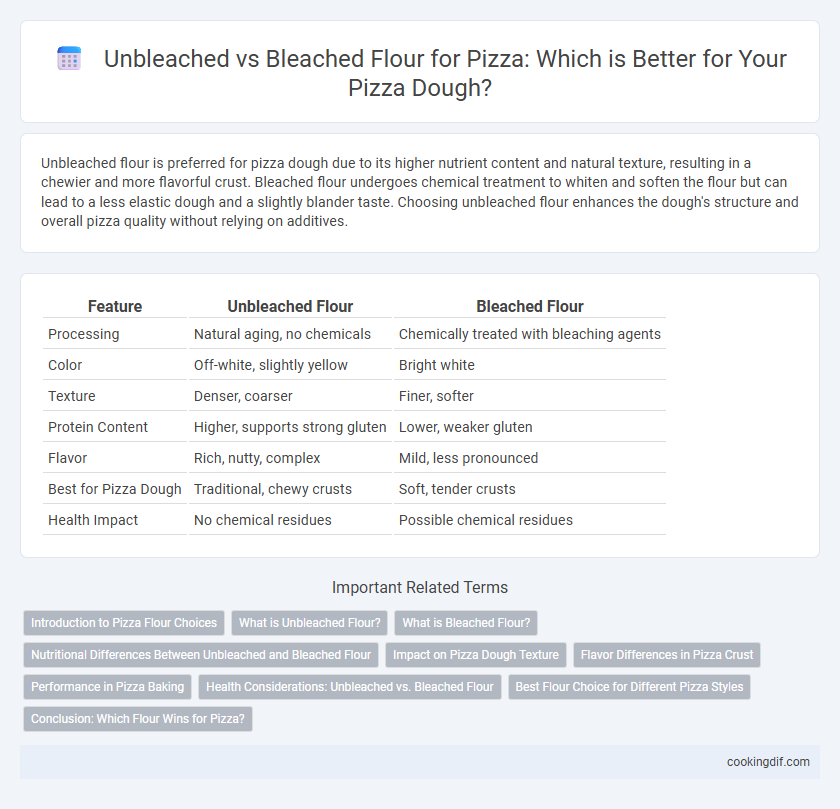Unbleached flour is preferred for pizza dough due to its higher nutrient content and natural texture, resulting in a chewier and more flavorful crust. Bleached flour undergoes chemical treatment to whiten and soften the flour but can lead to a less elastic dough and a slightly blander taste. Choosing unbleached flour enhances the dough's structure and overall pizza quality without relying on additives.
Table of Comparison
| Feature | Unbleached Flour | Bleached Flour |
|---|---|---|
| Processing | Natural aging, no chemicals | Chemically treated with bleaching agents |
| Color | Off-white, slightly yellow | Bright white |
| Texture | Denser, coarser | Finer, softer |
| Protein Content | Higher, supports strong gluten | Lower, weaker gluten |
| Flavor | Rich, nutty, complex | Mild, less pronounced |
| Best for Pizza Dough | Traditional, chewy crusts | Soft, tender crusts |
| Health Impact | No chemical residues | Possible chemical residues |
Introduction to Pizza Flour Choices
Unbleached flour retains natural nutrients and a slightly denser texture ideal for traditional pizza dough, enhancing flavor and chewiness. Bleached flour undergoes chemical treatment to whiten and soften the dough, producing a lighter, more tender crust but with reduced nutritional value. Choosing between unbleached and bleached flour impacts the pizza's texture, rise, and taste, making flour selection crucial for desired crust quality.
What is Unbleached Flour?
Unbleached flour is a type of wheat flour that undergoes minimal processing, preserving its natural color and nutrients without the use of chemical bleaching agents. It retains a higher protein content, which enhances gluten development and contributes to a chewier, more elastic pizza crust. This flour is preferred in pizza dough recipes for its robust texture and richer flavor compared to bleached flour.
What is Bleached Flour?
Bleached flour is chemically treated with agents such as chlorine or benzoyl peroxide to speed up the aging process, resulting in a finer texture and whiter color. This process can affect gluten formation, making the dough softer but less elastic, which may impact pizza crust structure. In contrast, unbleached flour retains natural pigments and develops gluten more naturally, often preferred for authentic, chewy pizza crusts.
Nutritional Differences Between Unbleached and Bleached Flour
Unbleached flour retains more natural nutrients such as vitamins E, B-complex, and minerals like magnesium and zinc, which are often diminished during the bleaching process. Bleached flour undergoes chemical treatment with agents like chlorine or benzoyl peroxide, leading to reduced protein content and lower antioxidant levels. Choosing unbleached flour for pizza dough enhances nutritional value by preserving essential nutrients that support digestion and overall health.
Impact on Pizza Dough Texture
Unbleached flour retains more natural bran and protein, resulting in a denser, chewier pizza dough with enhanced elasticity and a rustic texture. Bleached flour undergoes chemical treatment that weakens gluten development, yielding a softer, lighter dough ideal for thinner, crispier crusts. Choosing unbleached flour creates a sturdier base for toppings, while bleached flour offers a delicate crumb and tender bite.
Flavor Differences in Pizza Crust
Unbleached flour contributes to a richer, more complex flavor in pizza crust due to its higher protein content and natural aging process, which enhances gluten development and results in a chewier texture. In contrast, bleached flour, chemically treated to speed up aging, creates a softer crust with a slightly milder taste but less depth in flavor. Choosing unbleached flour can elevate the overall sensory experience of pizza by intensifying the crust's aroma and subtle nutty undertones.
Performance in Pizza Baking
Unbleached flour enhances pizza performance by providing a stronger gluten network, resulting in better dough elasticity and improved rise during baking. Its natural texture creates a chewy crust with a balanced crumb structure, essential for Neapolitan and New York-style pizzas. Bleached flour, treated with chemicals, often yields a softer dough but can compromise crust toughness and browning, affecting overall pizza quality.
Health Considerations: Unbleached vs. Bleached Flour
Unbleached flour retains more natural nutrients and undergoes minimal chemical processing, making it a healthier choice for pizza dough compared to bleached flour, which contains additives like benzoyl peroxide or chlorine that can affect nutritional quality. Consuming bleached flour regularly may pose risks such as inflammation and potential exposure to residual chemicals. Choosing unbleached flour supports better digestion and provides essential vitamins like B vitamins and antioxidants crucial for overall health.
Best Flour Choice for Different Pizza Styles
Unbleached flour, with its higher protein content and natural texture, is ideal for Neapolitan and artisan-style pizzas, promoting a chewy, flavorful crust. Bleached flour offers a finer grain and lighter color, suited for thin-crust and crispy styles like New York or Sicilian pizza where a tender crumb is preferred. Choosing the right flour type impacts dough elasticity, crust texture, and baking performance, tailoring the pizza base perfectly to each culinary style.
Conclusion: Which Flour Wins for Pizza?
Unbleached flour is preferred for pizza dough due to its natural milling process, which retains essential nutrients and provides better flavor and texture. Bleached flour, treated with chemicals for a whiter appearance, often results in a softer, less chewy crust that lacks depth. For authentic, robust pizza crusts, unbleached flour consistently delivers superior performance and taste.
Unbleached vs bleached flour for pizza Infographic

 cookingdif.com
cookingdif.com